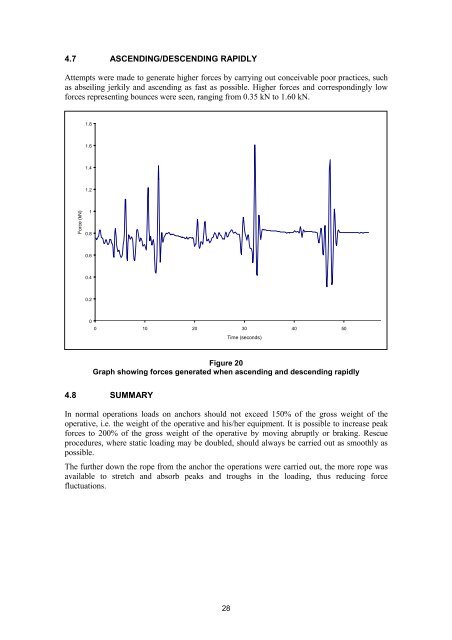HSE: Industrial rope access - investigation into items of personal ...
HSE: Industrial rope access - investigation into items of personal ...
HSE: Industrial rope access - investigation into items of personal ...
Create successful ePaper yourself
Turn your PDF publications into a flip-book with our unique Google optimized e-Paper software.
4.7 ASCENDING/DESCENDING RAPIDLY<br />
Attempts were made to generate higher forces by carrying out conceivable poor practices, such<br />
as abseiling jerkily and ascending as fast as possible. Higher forces and correspondingly low<br />
forces representing bounces were seen, ranging from 0.35 kN to 1.60 kN.<br />
Force (kN)<br />
1.8<br />
1.6<br />
1.4<br />
1.2<br />
1<br />
0.8<br />
0.6<br />
0.4<br />
0.2<br />
0<br />
0 10 20 30 40 50<br />
Figure 20<br />
Graph showing forces generated when ascending and descending rapidly<br />
4.8 SUMMARY<br />
In normal operations loads on anchors should not exceed 150% <strong>of</strong> the gross weight <strong>of</strong> the<br />
operative, i.e. the weight <strong>of</strong> the operative and his/her equipment. It is possible to increase peak<br />
forces to 200% <strong>of</strong> the gross weight <strong>of</strong> the operative by moving abruptly or braking. Rescue<br />
procedures, where static loading may be doubled, should always be carried out as smoothly as<br />
possible.<br />
The further down the <strong>rope</strong> from the anchor the operations were carried out, the more <strong>rope</strong> was<br />
available to stretch and absorb peaks and troughs in the loading, thus reducing force<br />
fluctuations.<br />
28<br />
Time (seconds)

















